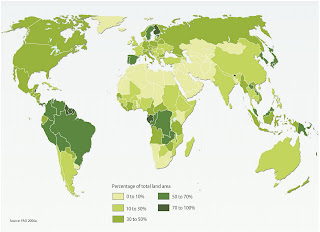The third group of elements of biodiversity encompasses the scales of ecological differences from populations, through habitats, to ecosystems, ecoregions, provinces, and on up to biomes and biogeographic realms. This is an important dimension to biodiversity not readily captured by genetic or organismal diversity, and in many ways is that which is most immediately apparent to us, giving the structure of the natural and semi-natural world in which we live. However, ecological diversity is arguably also the least satisfactory of the groups of elements of biodiversity. There are two reasons. First, whilst these elements clearly constitute useful ways of breaking up continua of phenomena, they are difficult to distinguish without recourse to what ultimately constitute some essentially arbitrary rules. For example, whilst it is helpful to be able to label different habitat types, it is not always obvious precisely where one should end and another begin, because no such beginnings and endings really exist.
In consequence, numerous schemes have been developed for distinguishing between many elements of ecological diversity, often with wide variation in the numbers of entities recognized for a given element. Second, some of the elements of ecological diversity clearly have both abiotic and biotic components (e.g. ecosystems, ecoregions, biomes), and yet biodiversity is defined as the variety of life. Much recent interest has focused particularly on delineating ecoregions and biomes, principally for the purposes of spatial conservation planning, and there has thus been a growing sense of standardization of the schemes used. Ecoregions are large areal units containing geographically distinct species assemblages and experiencing geographically distinct environmental conditions. Careful mapping schemes have identified 867 terrestrial ecoregions (Figure 2.1 and Plate 1; Olson et al. 2001), 426 freshwater ecoregions (Abell et al. 2008), and 232 marine coastal & shelf area ecoregions
(Spalding et al. 2007).
(Spalding et al. 2007).
Ecoregions can in turn be grouped into biomes, global-scale biogeographic regions distinguished by unique collections of species assemblages and ecosystems. Olson et al. (2001) distinguish 14 terrestrial biomes, some of which at least will be very familiar wherever in the world one resides (tropical & subtropical moist broadleaf forests; tropical & subtropical dry broadleaf forests; tropical & subtropical coniferous forests; temperate broadleaf & mixed forests; temperate coniferous forests; boreal forest/taiga; tropical &
subtropical grasslands, savannas & shrublands; temperate grasslands, savannas & shrublands; flooded grasslands & savannas; montane grasslands & shrublands; tundra; Mediterranean forests, woodlands & scrub; deserts & xeric shrublands; mangroves). At a yet coarser spatial resolution, terrestrial and aquatic systems can be divided into biogeographic realms.
subtropical grasslands, savannas & shrublands; temperate grasslands, savannas & shrublands; flooded grasslands & savannas; montane grasslands & shrublands; tundra; Mediterranean forests, woodlands & scrub; deserts & xeric shrublands; mangroves). At a yet coarser spatial resolution, terrestrial and aquatic systems can be divided into biogeographic realms.
Terrestrially, eight such realms are typically recognized, Australasia, Antarctic, Afrotropic, Indo-Malaya, Nearctic, Neotropic, Oceania and Palearctic (Olson et al. 2001). Marine coastal & shelf areas have been divided into 12 realms (Arctic, Temperate North Atlantic, Temperate Northern Pacific, Tropical Atlantic, Western Indo-Pacific, Central Indo-Pacific, Eastern Indo-Pacific, Tropical Eastern Pacific, Temperate South America, Temperate Southern Africa, Temperate Australasia, and Southern Ocean; Spalding et al. 2007). There is no strictly equivalent scheme for the pelagic open ocean, although one has divided the oceans into four primary units (Polar, Westerlies, Trades and Coastal boundary), which are then subdivided, on the basis principally of biogeochemical features, into a further 12 biomes (Antarctic Polar, Antarctic Westerly Winds, Atlantic Coastal, Atlantic Polar, Atlantic Trade Wind, Atlantic Westerly Winds, Indian Ocean Coastal, Indian Ocean Trade Wind, Pacific Coastal, Pacific Polar, Pacific Trade Wind, Pacific Westerly Winds), and then into a finer 51 units (Longhurst 1998).














0 comments:
Post a Comment